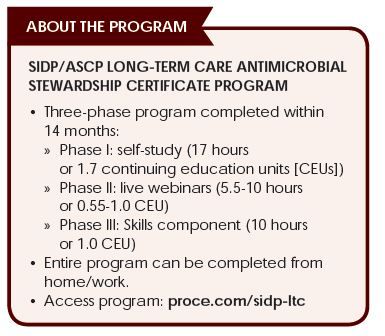A Long-Term Care Antimicrobial Stewardship Certificate Program for Pharmacists: Filling an Unmet Need
This training will empower pharmacists practicing in LTC facilities to develop antimicrobial stewardship programs, improve patient outcomes related to infectious diseases, and facilitate compliance with CMS requirements.
Antimicrobial resistance is a world­wide threat, resulting in more than 2 million infections and almost 25,000 deaths each year in the United States.1 Patients in long-term-care (LTC) facilities are considered to be at an increased risk of infection with multi­drug-resistant bacteria due to several factors. First, these patients generally have multiple comorbidities, making them more suscep­tible to infection. Second, patients in LTC facilities are also more likely to be exposed to an antimicrobial agent.2 Studies have shown that up to 70% of residents receive at least one course of systemic antibiotics per year, with 40% to 75% of those courses be­ing unnecessary or inappropriate.2,3 This in­creases not only the risk of colonization or infection because of a multidrug-resistant organism, but also the risk of antibiotic-associated adverse events, including Clostrid­ium difficile infection.2

Antimicrobial stewardship is now widely recognized as a key strategy to ensuring optimal patient outcomes while reducing the risk of antimicrobial resistance. In 2016, the Infectious Diseases Society of America and the Society for Healthcare Epidemiology of America published new antimicrobial stewardship guidelines, endorsed by the Society of Infectious Diseases Pharmacists (SIDP) and others.3 These updated guidelines recommend employing antimicrobial stewardship strategies to decrease antimicrobial use throughout LTC facilities. Soon after these recommendations were released, the Centers for Medicare & Medicaid Services (CMS) published a final rule requiring LTC facilities to establish an antibiotic stewardship program by November 28, 2017. The rule states that the program should consist of antibiotic use protocols as well as a system to monitor antimicrobial use.
Antimicrobial stewardship has been well studied in the acute care environment and focuses on a multifaceted, multidisciplinary approach for successful implementation.3 However, published data on effective stewardship strategies in the LTC environment are lacking. Those practicing in this arena may also have limitations because of lack of staffing or formal resources. The Centers for Disease Control and Prevention (CDC) released an adaptation of the core elements that specifically addresses 7 key strategies for antimicrobial stewardship in LTC facilities including nursing homes and long-term acute care hospitals (Box). These core elements highlight the essential components of antibiotic stewardship in this setting and the need for collaboration among pharmacists, physicians, and nurses.
In an effort to address the need for antimicrobial stewardship training in the LTC environment, the SIDP and the American Society of Consultant Pharmacists (ASCP) have worked together to develop the SIDP / ASCP Long-Term Care Antimicrobial Stewardship Certificate Program. This program consists of 3 phases and offers over 30 hours of the Accreditation Council for Pharmacy credit.
Phase I involves self-study modules that review basic microbiology, pharmacology, pharmacokinetics, and infectious disease state management relevant to antimicrobial stewardship in the LTC setting. Phase II engages participants in live webinars that address topics such as program implementation, key strategies that are needed within the LTC environment, optimization of outcomes, and regulation and compliance issues. The final phase requires the participant to complete a project that demonstrates individual mastery by applying what they learned (in the self-study and live webinars) to implement, evaluate, or modify some aspect of antimicrobial stewardship within their facility. This training will empower pharmacists practicing in LTC facilities to develop antimicrobial stewardship programs, improve patient outcomes related to infectious diseases, and facilitate compliance with CMS requirements.

Alan Gross, PharmD, BCPS-AQ ID, is a clinical assistant professor at University of Illinois at Chicago College of Pharmacy and the antimicrobial stewardship pharmacist at University of Illinois Hospital and Health Sciences System. He is past-chair of the SIDP Antimicrobial Stewardship Committee and is also an active member of SHEA, ACCP, and ASM.
Jessica Robinson, PharmD, BCPS is an associate professor at the University of Charleston School of Pharmacy and the Associate Director of the antimicrobial stewardship program at Charleston Area Medical Center in Charleston, WV. She is the Chair of the SIDP Antimicrobial Stewardship Committee.
Jamie Wagner, PharmD is a clinical assistant professor at the University of Mississippi School of Pharmacy. She currently serves on the SIDP Antimicrobial Stewardship Committee and is chair of the Long-Term Care Stewardship Subcommittee.
References:
- Antibiotic resistance threats in the United States, 2013. US Department of Health and Human Services, Centers for Disease Control and Prevention website. https://cdc.gov/drugresistance/threat-report-2013/pdf/ar-threats-2013-508.pdf. Published 2013. Accessed June 9, 2017.
- The core elements of antibiotic stewardship for nursing homes. Centers for Disease Control and Prevention website. https://cdc.gov/longtermcare/prevention/antibiotic-stewardship.html. Accessed June 9, 2017.
- Barlam TF, Cosgrove SE, Abbo LM, et al. Implementing an antibiotic stewardship program: guidelines by the Infectious Diseases Society of America and the Society for Healthcare Epidemiology of America. Clin Infect Dis. 2016;62(10):e51-e77. doi: 10.1093/cid/ciw118.
- State operations manual, appendix PP tag F441 §483.80. Centers for Medicare & Medicaid Services website. https://cms.gov/Regulations-and-Guidance/Guidance/Manuals/downloads/som107ap_pp_guidelines_ltcf.pdf. Revised March 8, 2017. Accessed June 9, 2017.
- The core elements of antibiotic stewardship for nursing homes. Centers for Disease Control and Prevention website. https://cdc.gov/longtermcare/pdfs/core-elements-antibiotic-stewardship.pdf. Published 2015. Accessed June 16, 2017.

